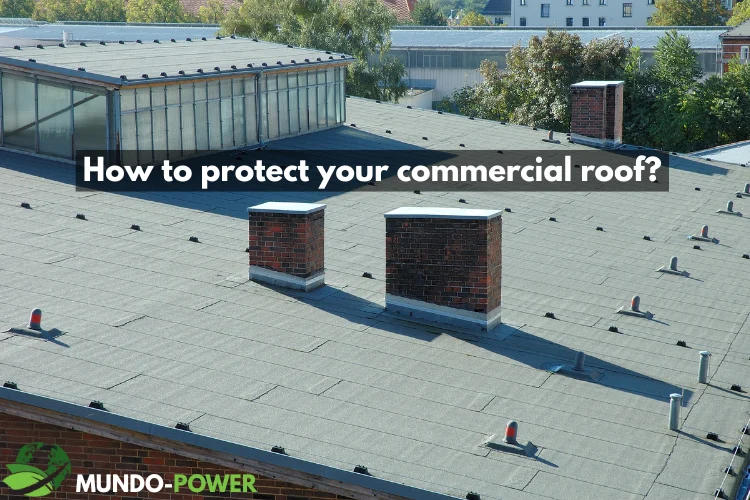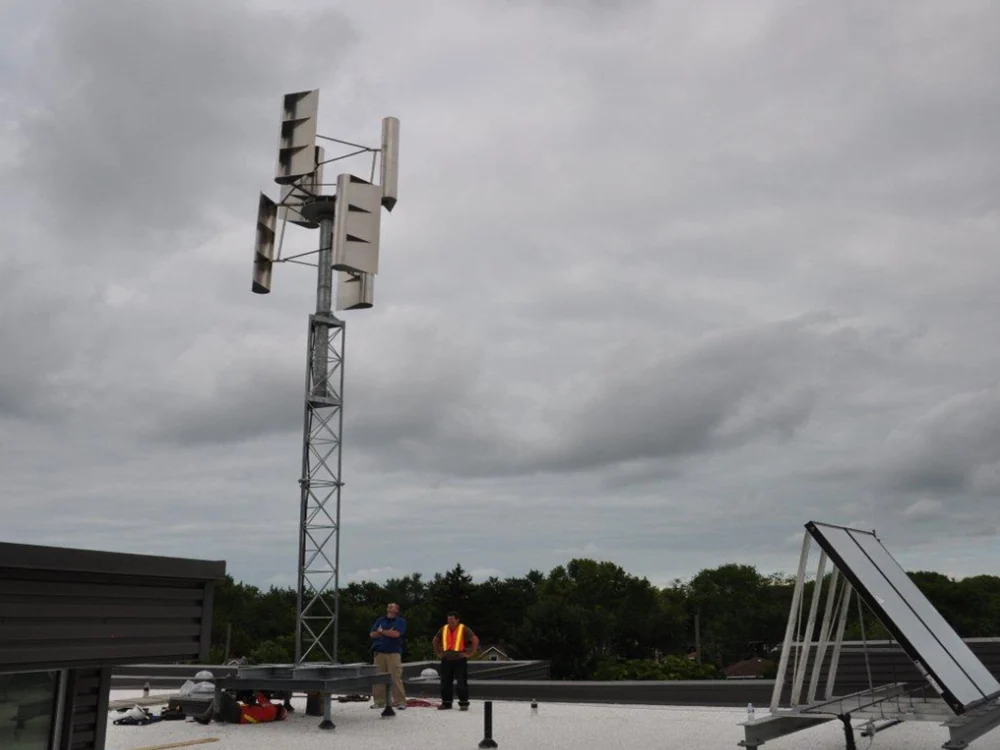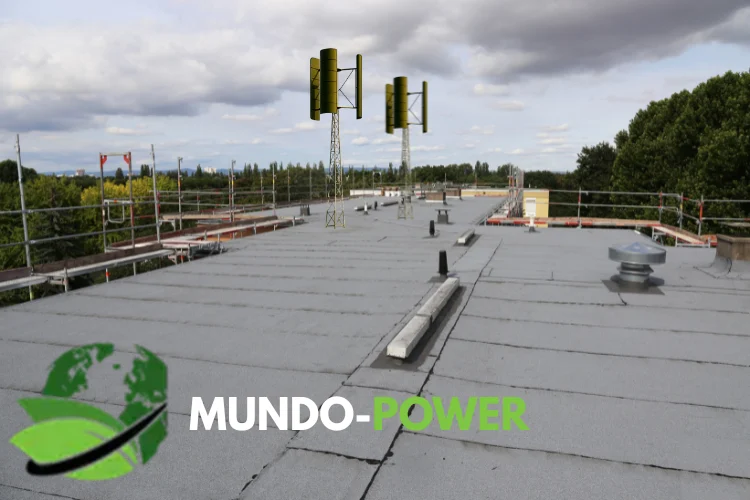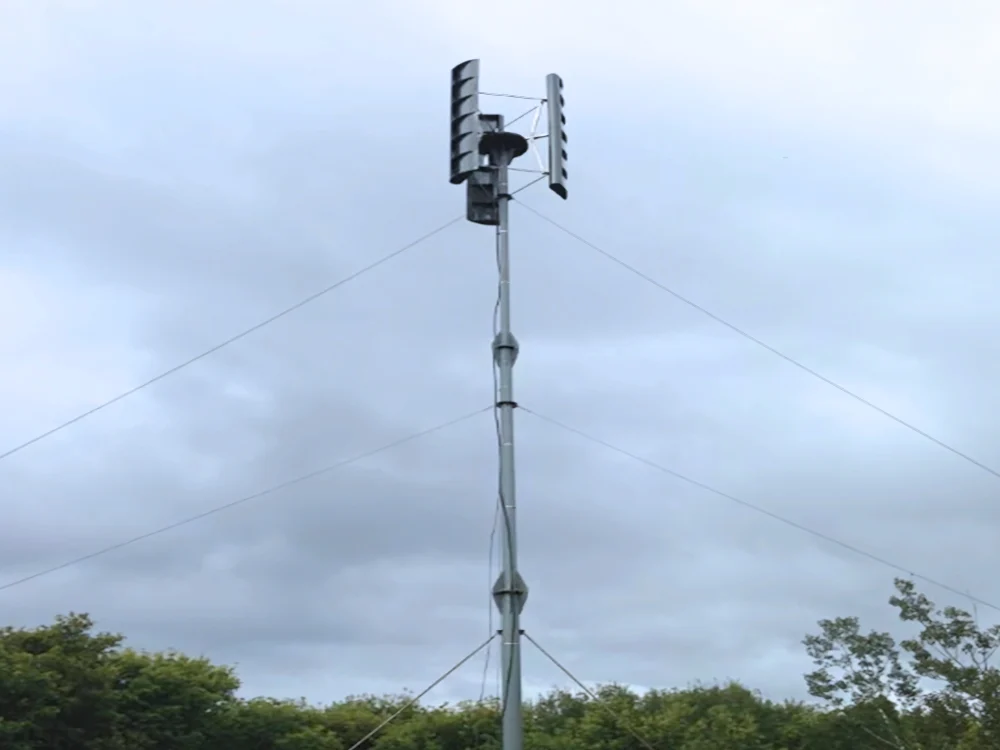
Running a large commercial building means constantly weighing costs against long‑term risks. Suppose you manage a property with a roof worth seven figures. In that case, you might be drawn to the promise of solar power: lower electric bills, environmental responsibility, and a bit of independence from the grid. Yet you may also worry about turning that flat roof into a construction site full of panels, mounts, and wires. You can have an industrial wind turbine without damaging your roof.
The stakes are high. A million‑dollar roof protects people, equipment, and revenue; any damage can snowball into expensive repairs and downtime. Rooftop solar can deliver savings, but only when the roof is designed for it and maintained relentlessly. For many high‑value roofs, a ground‑based hybrid system—such as Mundo Power’s portable microgrid or its stand‑alone vertical‑axis wind turbines—is the safer option.
What Makes Commercial Rooftop Solar Appealing?
Before diving into risks, it’s worth noting why solar keeps popping up in boardroom conversations. Electricity prices are volatile, and tax incentives make solar look attractive. A well‑sized array can trim utility bills and highlight a commitment to sustainability. Some studies even show modest gains in property value after installation.
- Lower electricity costs through on‑site generation
- Potential federal tax credits and accelerated depreciation
- Positive environmental and ESG branding
- Added protection for portions of the roof from UV rays and hail
These advantages are real, but they only hold when the roof can safely carry the load and the system is installed and maintained correctly.

How Heavy Is a Solar Array? Structural Limits and Hidden Costs
The first complex reality is weight. Each commercial solar panel weighs around 50 pounds. A typical 100‑kilowatt system requires about 250 panels, adding over 12,000 pounds spread across the roof. On average, rooftop arrays increase load by two to four pounds per square foot. That comes on top of existing roof materials, HVAC units, snow, and live loads of people.
Do Building Codes Account for Solar Weight?
Building codes generally require a minimum live-load capacity of 20 pounds per square foot, in addition to the permanent (dead) load of the roof. Solar panels are added to that dead load. Older roofs may not meet modern standards and could need reinforcement.
The way panels are mounted matters, too. Using fewer brackets concentrates the weight and increases the risk of leaks around those fasteners. A structural engineer should always review the framing and deck before a project begins. Installing panels on an aging roof can backfire—removing and reinstalling them later for replacement can be expensive and wipe out any energy savings.
Ignoring load capacity risks sagging, ponding water, or even structural failure. What appears to be a savings project can quickly become a liability.
Why Roof Penetrations Put Your Building at Risk
The most common way to secure solar panels is to bolt the racking into the roof deck. Each bolt pierces the membrane, creating a path for water. Even when appropriately sealed, hundreds of penetrations increase the odds that one will eventually fail. Because of this, industrial wind turbines can be a safer solution. Consider a Mundo-Power portable power trailer for best results.
Anchored vs. Ballasted Systems
Anchored systems eliminate panel movement but depend on flawless waterproofing. A single failed fastener can leak and void the roof warranty.
Ballasted systems use heavy concrete blocks to hold racks in place. While they avoid penetrations, the weight can crush insulation and cause panels to shift under wind pressure. Movement across the membrane can cause it to scuff or tear, leading to leaks and accelerated wear.
Both systems can block drains or trap debris. Accumulated sand, leaves, and moisture under ballasted trays can abrade the membrane and even fuel rooftop fires. Regardless of the system used, ongoing inspection is essential.
Maintenance, Foot Traffic, and Fire: The Overlooked Hazards
Solar panels are not “set it and forget it.” They require regular cleaning, electrical inspections, and sometimes snow removal. Each visit means more foot traffic on the roof.
Technicians carrying tools risk dropping sharp objects that puncture the membrane. Repeated walking compresses the insulation, creating low spots where water pools, which accelerates deterioration.
Fires pose another concern. Rooftop PV systems introduce three significant risks:
- Faulty connections or damaged wiring can arc and ignite roof materials.
- Heat trapped under panels accelerates fire spread compared to an open roof.
- Arrays continue generating electricity in daylight, complicating firefighting efforts and creating shock hazards.
Some insurers now restrict PV coverage to non-combustible roofs or require additional fire-resistant layers to be installed. It’s a risk many companies don’t consider until after installation.

Does Solar Extend or Shorten Your Roof’s Life?
Panels can shield the surface beneath them from direct UV rays and hail. However, that benefit is only available in covered areas. Uncovered sections weather at the standard rate, and temperature cycling around the array edges can add stress. Our systems provide both a wind and solar generator.
Most PV modules are rated to last 30–35 years. If your roof is already 15 years old, the smart move is to replace or overlay it before adding panels. Otherwise, you’ll face the cost of tearing down and reinstalling the array to fix the roof beneath it.
For companies with premium roofs, building a solar‑ready roof from the start is often the best path. That means stronger decking, higher‑grade membranes, and layouts that leave uninterrupted panel zones.
A Smarter Alternative for High‑Value Roofs
If your roof isn’t new, it isn’t designed for PV, or you can’t risk leaks and stress, renewable energy is still within reach. Mundo Power offers a hybrid solution that stays entirely off the roof.
What Does Mundo Power Offer?
Portable Wind Power
At the center is the Portable Power Trailer (PPT), a mobile unit that combines two 6.25-kilowatt vertical-axis wind turbines with 10 kilowatts of solar panels and up to 200 kilowatt-hours of battery storage. That’s over 22 kilowatts of clean power, day and night.

Commercial EV charging station
Since the trailer is on the ground, there are no concerns regarding roof penetration or load. It arrives fully assembled and can be operational within hours. If your needs change, you can relocate it or lease it to another site—flexibility rooftop systems can’t match.
Beyond the trailer, Mundo Power also offers stand‑alone vertical‑axis wind turbines rated at 6.25 kW and 500 W. These units can be installed as single towers or paired with small solar arrays to provide clean power without the footprint or structural burden of rooftop systems. Designed to operate quietly and withstand turbulent urban winds, they provide property owners with additional flexibility when space or regulations limit trailer placement. Like the portable microgrid, these turbines can be leased or redeployed as needs evolve.
Key benefits include:
- No roof modifications, trenching, or foundations
- Hybrid wind and solar generation for round‑the‑clock output
- Integrated battery storage for backup during outages
- Road‑legal trailer can move as demand shifts
- Quiet operation and proven wildlife safety
- Standalone 6.25 kW and 500 W turbines for sites where a trailer isn’t practical
- Commercial EV charging station
For businesses with expensive roofs, this eliminates the most significant risks of rooftop solar while still delivering meaningful savings and resilience.
Making the Right Choice for Your Roof: Choose a Portable Power Trailer
Rooftop solar can lower energy costs and highlight sustainability commitments, but it introduces weight, water, and fire risks that can threaten the very roof it sits on. If you pursue this option, invest in a solar‑ready roof and involve roofing and structural professionals from the outset.
For many companies—especially those with premium commercial roofs—ground-based options, such as Mundo Power’s portable power trailer and stand-alone vertical-axis turbines, offer the benefits of renewable energy without jeopardizing the building’s most valuable asset. Choosing the right system means looking beyond the allure of rooftop PV and embracing solutions tailored to your roof’s value and your organization’s risk tolerance.
